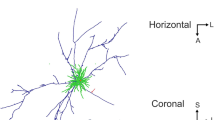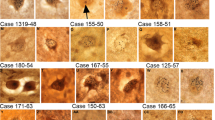Summary
Various types of pyramidal and stellate cells within the outer layers of the human isocortex have been studied with the aid of a newly developed technique for the successive examination of both the Golgi and the pigment picture of individual neurons (Braak, 1974). Pyramids and stellate cells differ with respect to their pigment deposits. In general, the lipofuscin granules are loosely arranged within pyramidal cells and stain but weakly, whereas stellate cells are either crammed with coarse and intensely staining grains or do not contain any aldehydefuchsin-positive pigment granule at all. Hence, part of the quantitative information that is given by the Golgi preparation is hidden within the pigment picture. Distinguishing characteristics of the pigment deposits allow the unequivocal determination of the cell type, thus enabling quantitative analysis of the distribution pattern and cell density of the various cortical elements.
The external granular (II) and the pyramidal (III) layer are populated by pyramids of varying size and stellate cells. The last group of neurons can be divided into pigment loaded and poorly pigmentated or pigment lacking elements.
The pigment loaden stellate cells occur within the outer layers of all fields of the isocortices of man. They have a small ovoid or polygonal cell body, stuffed with intensely staining lipofuscin granules, and giving off a medium number of smooth dendrites preferably oriented towards the surface. Such cells accumulate within the profound portions of the external granular layer (II) and the adjacent parts of the pyramidal layer (III) constituting a conspicuous band within pigment preparations. Its clear-cut upper border is marked by a sudden increase in the number of pigment-loaded stellate cells. Towards the profound parts of the pyramidal layer, on the contrary the packing density diminishes gradually. The pigment loaded elements are not arranged in columns but are of irregular distribution. Their over-all packing density does not vary within a certain cortical field. Alterations concerning their number and pattern of distribution occur between different cortical areas.
Zusammenfassung
Mit Hilfe einer neu entwickelten Technik für die aufeinander folgende Darstellung des Golgi- und Pigmentbildes an einzelnen Nervenzellen (Braak, 1974) werden die verschiedenen Arten von Pyramiden- und Sternzellen in den äußeren Schichten des menschlichen Isocortex untersucht. Auf Grund ihrer verschiedenartigen Pigmenteinlagerungen lassen sich Pyramiden- und Sternzellen voneinander unterscheiden. Im allgemeinen sind die Lipofuscinkörner in Pyramidenzellen locker verteilt und färben sich nur schwach an. Dagegen sind die Sternzellen entweder dicht mit groben, kräftig gefärbten Körnern angefüllt oder frei von aldehydfuchsin-positivem Pigment. Es ist also im Pigmentbild ein Teil der qualitativen Information des Golgibildes verborgen. Weil charakteristische Merkmale der Pigmentierung zugleich den Zelltyp kennzeichnen, ist mit Pigmentpräparaten eine quantitative Analyse des Verteilungsmusters und der Zelldichte der verschiedenen Elemente der Endhirnrinde möglich.
Die zweite und dritte Rindenschicht werden von Pyramiden wechselnder Größe und Sternzellen aufgebaut. Die Sternzellen können unterteilt werden in pigmentbeladene und pigmentfreie Formen.
Pigmentbeladene Sternzellen kommen in den äußeren Schichten aller Felder des menschlichen Isocortex vor. Sie haben einen kleinen, ovoiden oder polygonalen, mit kräftig gefärbten Lipofuscinkörnern angefüllten Zelleib, von dem eine mäßige Zahl nicht bedornter Dendriten ausgehen, die überwiegend zur Oberfläche gerichtet sind.
Derartige Zellen finden sich vor allem in tiefen Teilen der zweiten und angrenzenden Partien der dritten Rindenschicht, wo sie in Pigmentpräparaten einen deutlichen Zellstreifen bilden. Die scharf gezogene obere Grenze entsteht durch eine unvermittelt einsetzende Zunahme der Zellzahl. In Richtung auf die tiefen Teile der dritten Rindenschicht nimmt dagegen die Zelldichte allmählich ab. Die pigmentbeladenen Elemente sind nicht in Zellsäulen übereinander angeordnet, sondern ungleichmäßig verteilt. Im ganzen wird eine Populationsdichte erreicht, die innerhalb eines Rindenfeldes gleich bleibt. Dagegen zeigen sich Unterschiede in der Zellzahl und im Verteilungsmuster zwischen verschiedenen Rindenfeldern.
Similar content being viewed by others
References
Bailey, P., Bonin, G. von: The isocortex of man. Urbana: University of Illinois Press 1951
Bangle, R.: Gomori's paraldehyde-fuchsin stain. I. Physico-chemical and staining properties of the dye. J. Histochem. Cytochem. 2, 291–299 (1954)
Braak, E.: On the fine structure of pigment loaded stellate cells within the layer II and III of the human isocortex (in prep.)
Braak, H.: Über die Kerngebiete des menschlichen Hirnstammes. V.: Das dorsale Glossopharyngeus- und Vagusgebiet. Z. Zellforsch. 135, 415–438 (1972)
Braak, H.: On the structure of the human archicortex. I. The cornu ammonis. A Golgi and pigmentarchitectonic study. Cell Tiss. Res. 152, 349–383 (1974)
Braak, H.: Ein Verfahren zum Aufkleben dicker Gefrierschnitte. Mikroskopie (in press)
Braitenberg, V., Guglielmotti, V., Sada, E.: Correlation of crystal growth with the staining of axons by the Golgi procedure. Stain Technol. 42, 277–283 (1967)
Brinkmann, H., Bock, R.: Quantitative Veränderungen “Gomori-positiver” Substanzen in Infundibulum und Hypophysenhinterlappen der Ratte nach Adrenalektomie und Kochsalzoder Durstbelastung. J. Neuro-Visceral Rel. 32, 48–64 (1970)
Economo, C. von, Koskinas, G. N.: Die Cytoarchitektonik der Hirnrinde des erwachsenen Menschen. Wien und Berlin: Springer 1925
Einarson, L.: A method for progressive selective staining of Nissl and nuclear substance in nerve cells. Amer. J. Path. 8, 295–307 (1932)
Elftman, H.: Aldehydefuchsin for pituitary cytochemistry. J. Histochem. Cytochem. 7, 98–100 (1959)
Jones, E. G., Powell, T.P.S.: Electron microscopy of the somatic sensory cortex of the cat. I. Cell types and synaptic organization. Phil. Trans. B 257, 1–11 (1970)
Jones, E. G., Powell, T.P.S.: Electron microscopy of the somatic sensory cortex of the cat. II. The fine structure of the layers I and II. Phil. Trans. B 257, 13–21 (1970)
Koelliker, A.: Handbuch der Gewebelehre des Menschen. Bd. II Nervensystem des Menschen und der Thiere, 6. Aufl. Leipzig: Engelmann 1896
Lorente de Nó, R.: The cerebral cortex: architecture, intracortical connections and motor projections. In: Fulton, J. F., Physiology of the nervous system, p. 291–321. London-New York-Toronto: Oxford 1938
Lund, J. S.: Non pyramidal cells of layers I-IV of the monkey striate cortex. Anat. Rec. 166, 339 (abstr.) (1969)
Lund, J. S.: Organization of neurons in the visual cortex, area 17, of the monkey (Macaca mulatto). J. comp. Neurol. 147, 455–496 (1973)
Mitra, N. L.: Quantitative analysis of cell types in mammalian neocortex. J. Anat. (Lond.) 89, 467–483 (1955)
Moment, G. B.: Deteriorated paraldehyde: an insidious cause of failure in aldehyde-fuchsin staining. Stain Technol. 44, 52–53 (1969)
Pearse, A. G.E.: The histochemical demonstration of keratin by methods involving selective oxidation. Quart. J. micr. Sci. 92, 393–402 (1951)
Peters, A.: Stellate cells of the rat parietal cortex. J. comp. Neurol. 141, 345–374 (1971)
Peters, A., Kaiserman-Abramof, I. R.: The small pyramidal neuron of the rat cerebral cortex. The perikaryon, dendrites and spines. Amer. J. Anat. 127, 321–356 (1970)
Peters, A., Proskauer, C. C., Kaiserman-Abramof, I. R.: The small pyramidal neuron of the rat cerebral cortex. The axon hillock and initial segment. J. Cell Biol. 39, 604–619 (1968)
Ramón y Cajal, S.: Histologie du système nerveux de l'homme et des vertébrés. Paris: Maloine 1909. (Madrid: Consejo superior de investigaciones cientificas. Reprinted 1952 and 1955)
Romeis, B.: Mikroskopische Technik. München-Wien: Oldenbourg 1968
Rossbach, R.: Das neurosekretorische Zwischenhirnsystem der Amsel (Turdus merula L.) im Jahresablauf und nach Wasserentzug. Z. Zellforsch. 71, 118–145 (1966)
Sholl, D. A.: The organization of the visual cortex in the cat. J. Anat. (Lond.) 89, 33–46 (1955)
Sholl, D. A.: The organization of the cerebral cortex. London: Methuen 1956
Sholl, D. A.: A comparative study of the neuronal packing density in the cerebral cortex. J. Anat. (Lond.) 93, 143–158 (1959)
Sotelo, C.: Ultrastructural aspects of the cerebellar cortex of the frog. In: Neurobiology of cerebellar evolution and development (ed. R. Llinás), p. 327–371. Chicago: Amer. Med. Assoc., Education and research foundation 1969
Szentágothai, J.: Architecture of the cerebral cortex. In: Basic mechanisms of the epilepsies (eds.: H.H. Jasper, A. A. Ward, A. Pope), p. 13–28. Boston: Little, Brown & Co. 1969
Wall, E. J., Jordan, F.I.: Photographic facts and formulas. Boston: Amer. Photograph. Publ. Co. 1940
Wall, G.: Über die Anfärbung der Neurolipofuscine mit Aldehydfuchsinen. Histochemie 29, 155–171 (1972)
Author information
Authors and Affiliations
Additional information
Supported by the Deutsche Forschungsgemeinschaft (Br 317/6).
Rights and permissions
About this article
Cite this article
Braak, H. On pigment-loaded stellate cells within layer II and III of the human isocortex. Cell Tissue Res. 155, 91–104 (1974). https://doi.org/10.1007/BF00220286
Received:
Issue Date:
DOI: https://doi.org/10.1007/BF00220286




